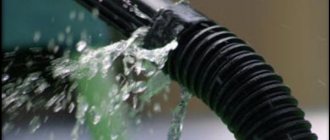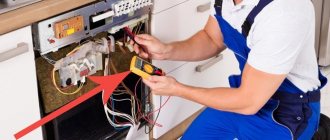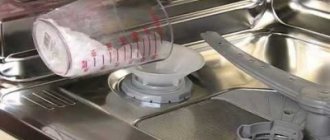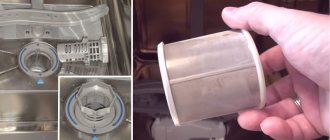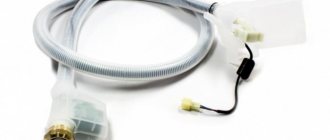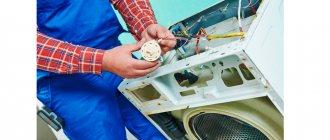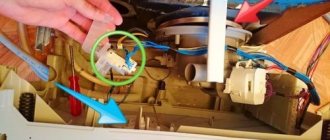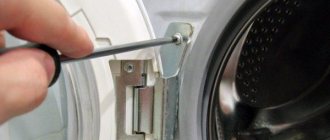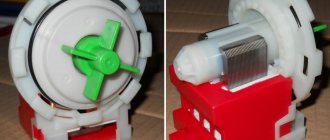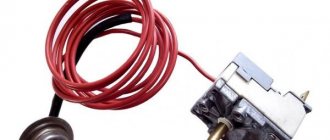Users of water-based household appliances hear these phrases all the time: in specialized stores, many sellers quite often insert these words into their speech when explaining the advantages of the home appliances they sell. What is the Aquastop system called, how is it used to actively protect the dishwasher, what does it consist of and how to replace it yourself - we will try to answer all these questions in the article.
What is Aquastop in a dishwasher?
Aquastop is a system that is equipped with the vast majority of modern dishwashers. To appreciate its benefits, you need to understand the purpose of the function.
Why do you need Aquastop in a dishwasher?
The dishwasher in the kitchen is connected to a water supply, the liquid in which is under strong pressure. In addition, from time to time so-called water hammers occur in pipes. In this case, the pressure additionally changes greatly, which can cause equipment leaks. Aquastop is a special system that prevents emergency situations. In case of leaks, it simply turns off the water supply to the dishwasher.
Attention! The system does not guarantee absolute protection and fails in approximately 8 cases out of 1000.
Aquastop is provided not only in dishwashers, but also in washing machines
Where is Aquastop located in the dishwasher?
Aquastop is a regular water supply hose enclosed in a special casing. In addition, the system includes:
- solenoid valve responsible for shutting off the liquid supply;
- pan with float sensor;
- electrical cable;
- excess water release button.
The main part of the system is located outside the dishwasher body. Inside in the bottom area there is only a tray with a float.
How does the Aquastop system work in a dishwasher?
The principle of operation of Aquastop in a dishwasher is quite simple. The diagram looks like this:
- When the unit is turned on, the safety valve is energized and opens.
- After pressing the “Start” button, the locking device is activated.
- The dishwasher begins the cleaning cycle.
- When leaks occur and water accumulates in the pan, the float sensor is activated.
- Upon a special signal, the contacts open.
- The power to the dishwasher turns off and the shut-off device shuts off the water supply.
To return the unit to operating condition, you need to eliminate the problem that caused the activation of the Aquastop function. After this, the system is reset and the dishwasher is started again.
Is it possible to connect a dishwasher without Aquastop?
The leak prevention system is quite useful, so it is not recommended to remove it when installing the kitchen unit. But if Aquastop in the dishwasher constantly works due to a malfunction and interferes with the use of the equipment. If no real leaks occur, it is quite possible to do without a safety valve.
It is easiest to connect budget devices without a special hose. They are equipped with a simple mechanism built into the inlet sleeve and do not have complex elements. Instead of a special kitchen dishwashing machine hose, you can use a regular hose that is suitable in length and other parameters.
If there are wires running inside the hose with the Aquastop system, then changing the design of the unit will be more difficult. It will be necessary not only to rearrange the inlet hose, but also to disconnect the extra cables connecting to the control module.
TOP 5 “dishwashers” with complete protection against leaks
BOSCH SMV 47L10 is a fully built-in model for 13 sets.
Electronic control, mini-display, child lock system, water purity sensor, “beam on the floor” indicator. Consumption per cycle is 12 liters. Contains 4 programs, half load possible. Allows the use of “3 in 1” products, the start of work is delayed for a period of 1 to 24 hours. HANSA ZWM 416 WH - narrow PMM for 9 sets. Refers to a high energy efficiency class (“A++”), supports electronic control. It takes 9 liters of water to wash, there are 6 modes and 5 heating levels. Supports partial loads as well as the use of universal cleaning tablets. The dish compartment is height adjustable.
INDESIT DISR 14B is a narrow built-in type device. Holds 10 sets of dishes (consumes 10 liters of water), is equipped with a compact display and a delay start timer. There are 4 modes, there is an additional BIO program. The set includes a pair of folding stands for cups and glasses.
SIEMENS SR 64E002 – narrow dishwasher “built-in” for 9 sets. It implements electronic control, is equipped with 4 main programs and supports half-loading. It is characterized by a low noise level and uses 9 liters of water per cycle. Among the additional options, the mode for washing pots and pans stands out. It is possible to delay the start for a period from 3 to 9 hours.
KORTING KDI 60165 is a fully built-in PMM that can accommodate up to 14 sets of dishes. Electronic control, digital display, economical class “A++”, half-load capability. It consumes 11 liters of water, makes minimal noise and has a wide selection of programs (8 washing modes, 5 temperature positions). Projects a “beam on the floor” and allows the use of cleaning tablets. Activation of the cycle is postponed for a period of 1 to 24 hours.
How to check the Aquastop hose in a dishwasher
If AquaStop is activated in the dishwasher, the unit does not turn on and does not draw water. An error code may appear on the display, sometimes this does not happen, but the equipment still does not start.
To check the system you need to:
- Turn off the water supply tap from the water supply.
- Disconnect the dishwasher from the power supply.
- Unscrew the hose with valve that fits the device body.
- Look inside the sleeve and see if there is a gap for water to pass through.
- Remove the front bottom panel of the dishwasher and check the condition of the tray.
- If necessary, drain the water from the container.
After this, all that remains is to unclip the Aquastop spring and reconnect the hose to the dishwasher.
Error codes E15, AL01 and others may indicate that Aquastop is triggered in the dishwasher, depending on the appliance model.
Water does not heat up to the required temperature
Defects associated with the water heating function occur in the operation of Bosch PMMs less frequently than previous breakdowns. All of them are associated with incorrect operation of the electric heater.
| Code | Description |
| E01 | There is a break in the heating element circuit or a violation of its contacts. The reason is that the electric heater burned out. In addition, the following are possible: a break in the cable connections of the circuit, a malfunction of the triac on the ECU board that controls the operation of the heating element |
| E2 | The temperature sensor (hereinafter also referred to as the thermistor) has failed or its connection with the control unit has been broken. The error may appear simultaneously with E01 |
| E09 | This error appears only in those Bosch PMM models that have a flow-through heating element built into the pump. The reason is damage to the heater or a violation of the integrity of its circuit |
| E11 | The thermistor turns off due to several reasons: open circuit, lack of supply voltage, or poor contact in the connector or on the ECU board |
| E12 | Too much scale has formed on the surface of the heating element. Often, after rebooting the dishwasher (in order to reset this error), failure code E09 appears |
Indication of a malfunction of the electric heater built into the pump
To determine the integrity of the heater and electronic circuits, use a proven method - diagnose them with a multimeter. A working heating element has a resistance of about several tens of ohms. The resistance at the temperature sensor contacts should be within 50 kOhm. If during testing the device shows a break or short circuit, the part must be replaced with a serviceable one.
If E12 is defective, you can get rid of scale on the heater by washing it with a solution of vinegar or citric acid.
How to clean Aquastop in the dishwasher
Aquastop protection in the dishwasher requires cleaning from time to time. In addition to the inlet hose through which the water flows, the inner chamber filters require maintenance. These parts most often become clogged with intensive use of equipment and provoke errors and leaks.
To clean a hose with the Aquastop system, you must:
- Completely disconnect the machine from power and water supplies.
- Unscrew the hose with Aquastop.
- Look inside the sleeve and assess its condition.
- If there is heavy rust, limescale or other deposits, clean the hole with a toothpick.
- Carefully rinse the hose to remove any remaining dirt.
- Place the sleeve in place.
If Aquastop operates frequently, it is recommended to pay attention to the filters located at the bottom of the dishwasher. If they are heavily contaminated, water leaves the inner chamber less easily and leaks may appear. Maintenance is carried out according to the following scheme:
- Remove all the inner baskets from the machine and remove the sprinkler at the bottom.
- Pull up or twist clockwise the filter in the shape of a mesh cup.
- Remove dirt and thoroughly wash the part with warm water and laundry soap.
After this, the filter is dried on a towel without using heating devices and placed back in the nest.
Advice! To avoid leaks and other malfunctions, preventive cleaning of Aquastop and other parts is carried out every 2-3 months.
conclusions
- In most budget PMMs, only the housing is protected from leaks. Higher-class machines often have a more efficient system - in addition to the body, they also protect the outer hose.
- The presence of 100% protection does not actually affect the cost of the dishwasher. It is all the more advisable to choose a model that will be completely protected from leaks.
- The criterion under consideration is not key when purchasing PMM. Typically, buyers pay attention to the design, price, loading, brand, number of baskets and other things that catch the eye or affect the cost/quality of the machine. But in vain. If a flood occurs, the losses may exceed the cost of the equipment.
If, when choosing a PMM, you prefer a model with 100% leakage protection, this will not greatly affect your wallet. But your dishwasher will be under complete control, and you will be insured against troubles associated with a flood.
Source
How to change Aquastop in a dishwasher
The Aquastop valve design of the dishwasher is quite reliable, but sometimes the element requires replacement. It’s quite easy to do it even without contacting the service. The procedure is performed like this:
- Disconnect the machine from the power supply by removing the plug from the socket.
- The water supply is shut off using shut-off valves at the junction with the water supply.
- Manually unscrew the old hose with the Aquastop valve.
- If there is an electrical cable, remove the plug from the dishwasher.
- Install a new hose in the vacant space, performing the steps in reverse order.
In order for the dishwasher to work properly, it is better to buy Aquastop for it exactly the same as it was before.
It is necessary to tighten the hose with Aquastop securely so that water does not leak due to a poor connection
There is a current leak
When a machine gives an electric shock, it is extremely dangerous for all the inhabitants of the apartment and the first signal is that somewhere inside there is broken wiring insulation or there is a malfunction of the heating device. Therefore, a short circuit to the housing occurs - a thorough check of the entire electrical system is necessary. We have already written about how to ring an element; at the same time, you need to check all the wiring and other electrical components in the same way.
Do-it-yourself repair of Bosch dishwashers will cost users much less than calling a service center specialist, which costs from 500 to 1.5 thousand rubles.
Statistics say that Bosch machines occupy a strong leading position in the world in terms of repair costs, and spare parts have astronomical prices. By doing all the work yourself, you can save a decent amount and spend it on something more pleasant in all respects. And this video will help you do everything right.
Why does Aquastop work on a dishwasher?
The Aquastop function in a dishwasher can work for several reasons. Most often the system is activated:
- blockages in the unit or in the sewer that prevent waste water from draining;
- uncontrolled flow of liquid due to a broken hose or a malfunction of the supply valve;
- sudden changes in pressure in the water supply, or water hammer.
Also, the system is triggered due to its own malfunctions - skewed float, deformation of the pan or loose fixation of the hose.
How to unlock and what to do if Aquastop works in the dishwasher
If the Aquastop function has been activated in the dishwasher, you must first turn off the device completely. The water supply is shut off with a valve located at the outlet of the water supply system. The machine is turned off from the network by removing the plug from the socket.
After this, it is necessary to find out the reasons for the system’s operation. The following actions need to be taken:
- Check the dishwasher tray and drain excess water.
- Thoroughly clean the filter elements, inlet and outlet hoses.
- Make sure the pump and motor of the unit are in good condition.
- Repair or replace all broken elements of the device.
- If the protective system itself fails, dismantle it and install a new one.
Resetting Aquastop in the dishwasher after troubleshooting is very easy. You need to press a special button or spring on the valve, which opens the passage for water.
When the leakage protection is triggered, it is not recommended to simply return the system to its original state and continue to operate the machine. The problem that caused the activation of the Aquastop valve will make itself felt again and may get worse. Continued use of the dishwasher without repair will most likely lead to its final failure.
Attention! If the unit leaks and a puddle forms on the floor, it is better to turn off the power to the device through the distribution panel.
About functionality
Many owners are sure that the pressure in the water supply system of their home is low. This means that there is no need to use additional protection against leaks. In fact, not everyone knows that water supply networks are subject to frequent pressure changes and the formation of sudden water hammers. In these situations, the Aquastop hose for the Zanussi dishwasher will save you from flooding.
The standard Aquastop mechanism consists of the following elements:
- Electromagnetic or mechanical locking blocks.
- Flexible tube for filling water.
- Pan and float.
- Security wiring.
- Buttons for releasing excess water.
Flexible tube for filling water
How to turn off Aquastop in a dishwasher
Aquastop in a dishwasher is not a switchable function. It cannot be put into inactive state by simply pressing a button. The safety valve is built into the design of the kitchen unit itself.
If for some reason it is necessary to completely remove Aquastop from the dishwasher, this can only be done by removing the old hose and installing a new one. Instead of a protective element, it is allowed to install a conventional solenoid valve from a washing unit. It will cope well with the passage of water, but will not block its flow during water hammer and other emergency situations.
Aquastop fails faster with increased water hardness
Self-installation
Replacing an old hose is not a difficult job - we turn off the water and dismantle the hose, and install a new one in its place. If you used a system with a solenoid valve, then you need to carefully connect the wire with the plug to the sensor, which is located next to the filler inlet on the machine.
Any system is quite effective and protects your household appliances from various leaks and troubles that end in a flood. It’s not for nothing that experts advise installing Aquastop protection systems; they work simply - any user who does not have any technical knowledge can carry out the replacement.
We extract and parse the required element
The disassembly of the machine is completed by “removing” the drum. Naturally, you cannot halve the tank with your bare hands - the structure is reliably protected from depressurization. In order not to damage the “shell”, it is necessary to clarify the material and method of connecting the tank tank.
Most Bosch washing machines come with collapsible plastic tanks, making them easier to separate. To halve the tank, just loosen the clamps or unscrew the bolts around the perimeter. In the first case, we use a screwdriver or a knife, in the second, we take out a screwdriver.
Then the sequence is like this:
- remove the lower half of the tank;
- dismantle the pulley;
- Insert a bolt in place of the pulley and knock out the shaft.
If the shaft does not give in, then you need to generously lubricate the joint with WD-40 and repeat the procedure after 15 minutes. Afterwards, the drum will leave the tank and will be ready for subsequent repair of the bearing assembly or other planned manipulations.

